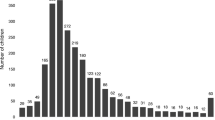Abstract
Purpose
To evaluate the office probing and minimal irrigation under topical anesthesia in congenital nasolacrimal duct obstruction for children older than 1 year.
Methods
Office probing and minimal irrigation under topical anesthesia were carried out on 88 lacrimal systems of 76 children (39 male and 37 female) with an age range of 7 to 60 months (mean: 18 months). If the relief of the symptoms of epiphora was not achieved with the first probing, a second probing and irrigation was performed with the same strategy 2 weeks after the first probing. The patients were followed up for 3.5 to 30 months (mean: 10 months).
Results
The cure rate was 75% with the initial office probing and irrigation, and 90.9% with the repeat probing. Complications, such as laceration of the puncta or canaliculus, creating a false passage, cellulitis, or aspiration of irrigating fluid were not seen in the patients.
Conclusions
A simple office probing and irrigation for the treatment of epiphora under topical anesthesia can be easily and safely performed for older children by an experienced ophthalmologist if there is no question with regard to the children’s airways and systemic health.
Similar content being viewed by others
References
Katowitz JA, Michael GW. Timing of initial probing and irrigation in congenital nasolacrimal duct obstruction. Ophthalmology 1987;94:698–705.
Del Monte MA, Archer SM. Nasolacrimal duct procedure. In: Atlas of Pediatric Ophthalmology and Strabismus Surgery. New York: Churchill Livingstone, 1994: pp. 211–216.
Noda S, Hayasaka S, Setogawa T. Congenital nasolacrimal duct obstruction in Japanese infants: its incidence and treatment with message. J Pediatr Ophthalmol Strabismus 1991;28:20–22.
Macewen CJ, Young JDH. Epiphora during the first year of life. Eye 1991;5:596–600.
Wagner RS. Lacrimal disorder. In: Ophthalmology Clinics of North America, Pediatric Ophthalmology, (Olitsky SE, ed.), Philadelphia: W. B. Saunders, 1996; pp. 229–237.
Kassoff J, Meyer DR. Early office-based vs late hospital-based nasolacrimal duct probing. A clinical decision analysis. Arch Ophthalmol. 1995;113:1168–1171.
Robb RM. Success rates of nasolacrimal duct probing at time intervals after 1 year of age. Ophthalmology 1998;105:1307–1310.
Zwaan J. Treatment of congenital nasolacrimal duct obstruction before and after the age of 1 year. Ophthalmic Surg Lasers 1997;28:71–72.
Honavar SG, Prakash VE, Rao GN. Outcome of probing for congenital nasolacrimal duct obstruction in older children. Am J Ophthalmol. 2000;130:42–48.
El-Mansoury J, Calhoun JH, Nelson LB, Harley RD. Results of late probing for congenital nasolacrimal duct obstruction. Ophthalmology 1986;93:1052–1054.
Stager D, Baker JD, Frey T, Weakley DR Jr., Birch EE. Office probing of congenital nasolacrimal duct obstruction. Ophthalmic Surg. 1992;23:482–484.
Kushner BJ. Congenital nasolacrimal system obstruction. Arch Ophthalmol. 1982;100:597–600.
Basarer T, Surel Z. Cocuklarda lakrimal drenaj sistemi bozukluklari [Disorders of lacrimal drainage system in children]. Turkish J Ophthalmol. 1978;8:39–47 (in Turkish).
Author information
Authors and Affiliations
Corresponding author
Additional information
The authors have stated that they do not have a significant financial interest or other relationship with any product manufacturer or provider of services discussed in this article. The authors also do not discuss the use of off-label products, which include unlabeled, unapproved, or investigative products or devices.
Rights and permissions
About this article
Cite this article
Basar, E., Oguz, H., Ozdemir, H. et al. Outcome of office probing and irrigation under topical anesthesia for congenital nasolacrimal duct obstruction. Ann Ophthalmol 37, 95–98 (2005). https://doi.org/10.1385/AO:37:2:095
Received:
Accepted:
Issue Date:
DOI: https://doi.org/10.1385/AO:37:2:095




